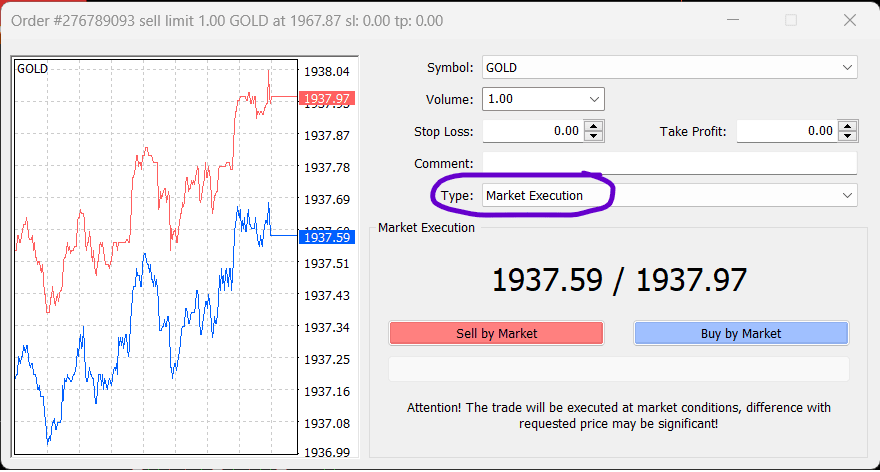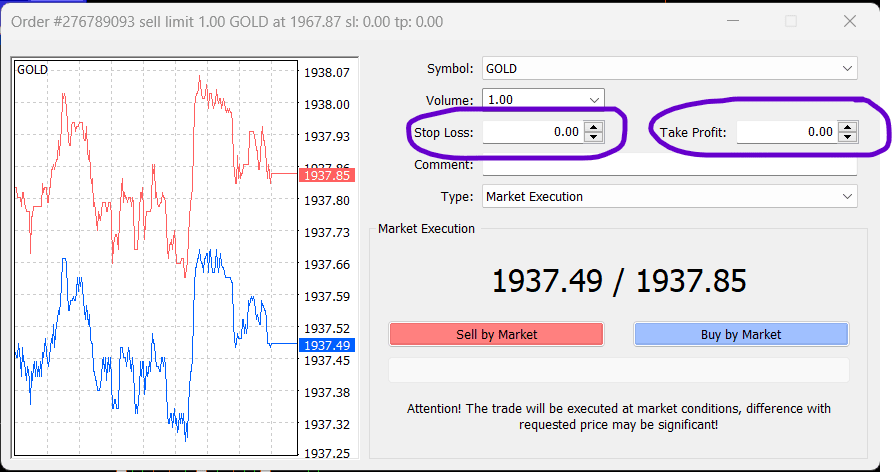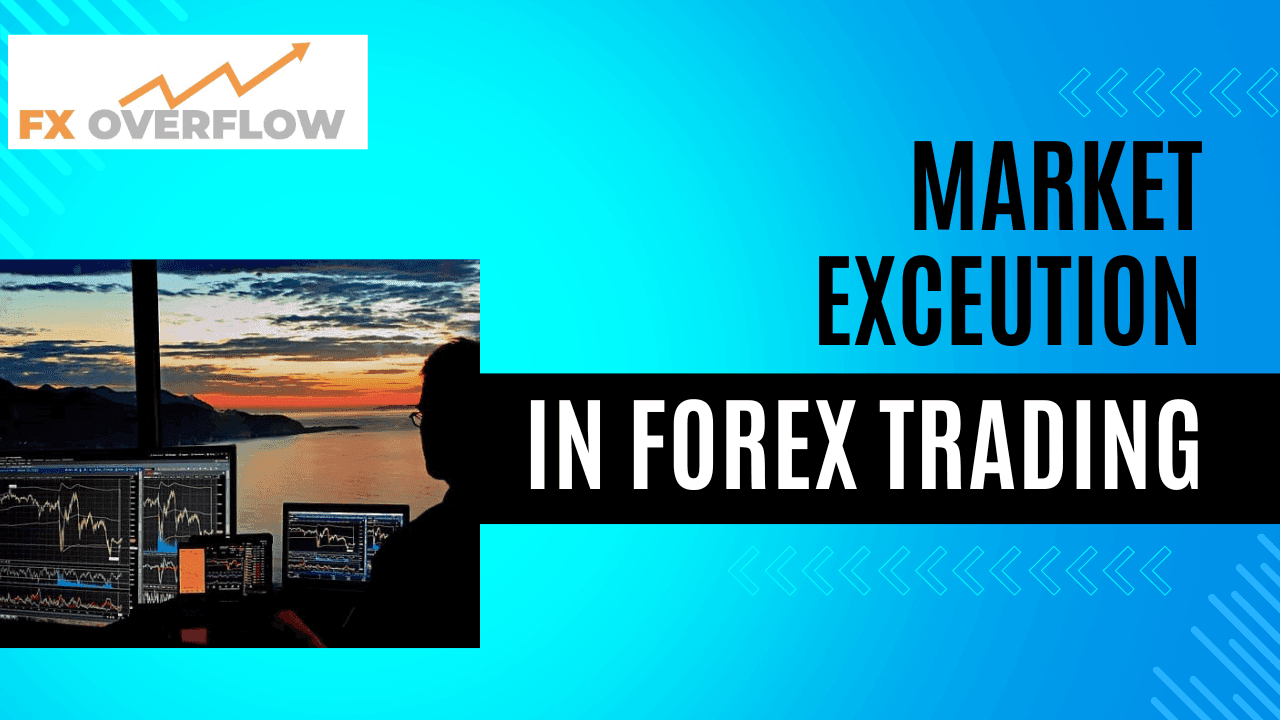Understanding Market Execution in Forex Trading in MT4 terminal: A Comprehensive Guide
Market Execution in Forex Trading
Forex trading, also known as foreign exchange trading, involves buying and selling currencies in the global market. As a forex trader, executing trades efficiently and at the best available price is crucial. In the MetaTrader 4 (MT4) terminal, traders have the option of using market execution to achieve this. In this comprehensive guide, we will delve into the intricacies of market execution in forex trading using the MT4 terminal.
What is Market Execution?
Market execution, in the context of forex trading, refers to the process of executing trades at the prevailing market prices. When a trader decides to enter or exit a trade, their order is executed immediately at the best available price in the market. This method ensures that trades are executed swiftly and at the most favorable price achievable at that moment.
How Does Market Execution Work in MT4?
Market execution in MT4 is a method of order execution that enables traders to buy or sell financial instruments at the current market price. It works by executing the order instantaneously at the best available price in the market. Here's a detailed explanation of how market execution works in MT4:
- Placing a Market Order: To use market execution, you begin by opening the Order window in MT4. You can do this by right-clicking on the desired financial instrument in the Market Watch window and selecting "New Trade," or by clicking on the "New Order" button in the toolbar. Another option is to use the keyboard shortcut F9.

- Setting Trade Parameters: In the Order window, you specify the trade parameters for the market order. This includes selecting the volume or quantity of the financial instrument you wish to buy or sell. The trade volume is usually denoted in lots, where one lot represents a standard size of the instrument. You can also choose to enter the volume in units or select a predefined volume from the drop-down menu.
- Choosing Market Execution: In the Order window, there is a "Type" field where you can select the order execution type. To use market execution, choose "Market Execution" from the drop-down menu. This indicates that you want the order to be executed immediately at the current market price.

- Indicating Buy or Sell: Next, you need to specify whether you want to buy or sell the financial instrument. Click on the "Sell by Market" button if you want to sell the instrument or the "Buy by Market" button if you want to buy it. You can also find this in the above image.
- Optional Stop Loss and Take Profit: If you wish to set a stop loss or take profit level for your order, you can do so in the Order window. A stop loss is a predetermined price at which your position will be automatically closed to limit potential losses. A take profit is a predetermined price at which your position will be automatically closed to secure potential profits. These levels can be set in terms of specific price levels or as a certain number of pips.
- Executing the Order: After specifying all the necessary details, click on the "Sell by Market" or "Buy by Market" button to execute the order. MT4 will promptly execute the order at the best available market price. You will receive a confirmation message indicating that the order has been executed.
- Monitoring the Trade: Once the market order is executed, you can monitor the trade in the "Trade" tab at the bottom of the MT4 platform. This tab displays essential information such as the trade volume, entry price, current market price, profit/loss, and more. If needed, you can modify or close the trade from this tab.
It's important to note that market execution is influenced by market conditions such as liquidity and price fluctuations. The actual execution price may vary slightly from the displayed price due to these factors, particularly during times of high market volatility or low liquidity.
By utilizing market execution in MT4, traders can swiftly enter trades at the prevailing market price, making it suitable for strategies that require immediate execution. This order execution method enables efficient trading and allows traders to take advantage of market opportunities as they arise.
Key Features of Market Execution:
· Speed: Market execution ensures fast execution of trades, allowing traders to take advantage of market movements promptly. This is particularly beneficial in volatile markets, where prices can change rapidly.
· Transparency: With market execution, traders have full visibility into the execution process. They can see the actual prices at which their orders are executed, ensuring transparency in the trading process.
· Best Available Price: Market execution guarantees that traders receive the best available price at the time of execution. This means that traders can benefit from price improvements, ensuring they get the most favorable outcome for their trades.
Market Execution vs. Instant Execution
It's essential to understand the difference between market execution and instant execution, another popular execution method in forex trading.
Market Execution: With market execution, orders are executed at the prevailing market price, providing traders with the best available price at the time of execution. This method is suitable for traders who prioritize speed and want their orders to be executed swiftly without delays.
Instant Execution: In contrast, instant execution allows traders to set a specific price at which they want their order to be executed. If the market reaches the desired price, the order is executed. However, if the market does not reach the specified price, the order is not executed. This method gives traders more control over the execution price but may result in order rejections or delays.
Advantages of Market Execution:
- Speed and Efficiency: - Market execution allows traders to enter or exit positions quickly, as orders are executed at the current market price without delays. This is particularly advantageous in volatile market conditions when prices can change rapidly.
- Best Available Price: - Market execution ensures that traders obtain the best available price at the moment the order is executed. This helps reduce slippage, which is the difference between the expected price and the actual execution price.
- Real-Time Market Conditions: - By using market execution, traders can take advantage of real-time market conditions and execute trades based on the most up-to-date prices. This is essential for capturing opportunities in fast-moving markets.
- Suitable for Scalping and Day Trading: - Market execution is well-suited for scalping and day trading strategies that require quick order execution and frequent trades.
· Instantaneous Order Execution: - One of the primary advantages of market execution is the speed at which orders are executed. By choosing market execution, traders can swiftly enter or exit positions without delays, ensuring that they capitalize on market opportunities as they arise.
· Price Certainty: - With market execution, traders receive immediate price certainty. The trade is executed at the best available price in the market at the time the order is placed. This helps traders avoid price slippage and ensures that they are filled at a price they expect.
· Reduced Requotes: - Market execution significantly reduces the occurrence of requotes. Requotes happen when the price at which a trader wants to execute a trade is no longer available, leading to a request for a new quote. As market execution executes orders at the current market price, the likelihood of requotes is minimized.
· Increased MarketSite: - By utilizing market execution, traders can benefit from the high liquidity of the forex market. Market orders are generally filled quickly due to the abundance of buyers and sellers in the market. This allows traders to enter or exit positions without significant price slippage.
Considerations and Limitations:
- Price Fluctuations: - Market execution is subject to price fluctuations, especially during volatile market conditions. The execution price may vary slightly from the displayed price due to these fluctuations.
- Slippage: - While market execution aims to minimize slippage, it can still occur, particularly during periods of high market volatility or low liquidity. Slippage can result in trades being executed at a different price than expected.
- Order Size: - Market execution may be less suitable for executing large orders, as significant order sizes can potentially impact market liquidity and lead to larger slippage.
- Instant Execution: - Market execution provides immediate order execution at the current market price. It does not offer the option for order modification or reconfirmation once the order is placed.
· Volatile Market Conditions: - While market execution excels in swiftly executing trades, it is important to exercise caution during periods of high market volatility. Rapid price fluctuations can increase the likelihood of slippage, where trades are executed at a different price than expected.
· Broker Selection: - When opting for market execution, it is crucial to choose a reputable broker that offers reliable order execution and competitive pricing. Traders should consider factors such as order execution speed, liquidity providers, and the broker's overall reputation.
Market Execution vs. Pending Orders
While market execution is a widely used execution method, it is essential to understand its key differences from another commonly used method, known as pending orders. Pending orders involve setting specific conditions for the trade to be executed in the future, whereas market execution executes trades immediately at the prevailing market price.
With market execution, traders have more control over the precise entry and exit points of their trades. On the other hand, pending orders provide traders with the ability to plan their trades in advance and execute them automatically when certain conditions are met.
Conclusion:
Market execution is a powerful tool for Forex traders, enabling them to execute trades swiftly and efficiently. By implementing market execution strategies in the MT4 terminal, you can optimize your trading performance, minimize requotes, and maximize your potential profits. Stay informed, practice risk management, and utilize the features provided by MT4 to elevate your trading experience.
Remember, successful Forex trading requires continuous learning, adaptability, and a disciplined approach. Incorporate market execution into your trading strategy and watch as your trading endeavors reach new heights.
FAQ
Q: Is market execution suitable for all types of traders?
A: Yes, market execution is suitable for all types of traders, including scalpers, day traders, and swing traders, as it offers instant order execution at the prevailing market prices.
Q: Can market execution result in slippage?
A: While market execution aims to minimize slippage, it is possible to experience slippage during periods of high volatility or when there is a lack of liquidity in the market.
Q: Are there any additional costs associated with market execution?
A: Market execution itself does not incur any additional costs. However, keep in mind that spreads and commissions charged by your broker may apply.
Q: How does market execution differ from instant execution?
A: Market execution and instant execution are both order execution methods, but they differ in how orders are filled. Market execution fills orders at the prevailing market prices, while instant execution fills orders at the exact price specified by the trader, assuming it is available in the market.
Q: Can I use market execution for automated trading systems?
A: Yes, market execution can be used for automated trading systems. It allows for quick and accurate execution of trades, which is beneficial for automated strategies.











Discussion